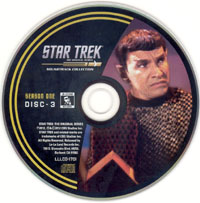Mudd's Women
This is one of the strangest entries amongst Star Trek's earliest episodes,
and it is stranger still to learn that it was one of the three scripts
competing for the position of the show's second pilot. While it may work
as an off-beat entry for the middle of a season, it's quite hard to believe
that anyone considered that it might sell the series to a network.
Though it has some outdated concepts at its core and flaunts those as a draw
for the audience, the story has a surprising number of redeeming elements
as well which may not be remembered quite so vividly until one hauls it
out and has another look at it.
Perhaps the earliest concept was that of the lovable old rogue.
Actor Roger C. Carmel is brought in to play Harry Mudd, and was successful
enough to warrant recurring appearances both in the second season and
in the animated series. Curiously, he starts out with quite a heavy Irish accent,
which gradually becomes less and less pronounced as the episode proceeds.
Early on, the episode makes a bit of a meal out of the fact that the crew
is guessing what Mudd's real scheme(s) may be, and with them the audience
is trying to guess what this episode is all about - with the most obvious
answers that come to mind seeming a bit risqué and unsuitable
for 1960's American television. Is it a prostitution ring? A mail-order bride scam?
An alien metamorphosis designed to incapacitate the crew? Some bizarre combination
of all of the above? At times, the story seems to be leading towards these things
artificially to create some extra drama. This story contains its fair share of fluff.
One of the down sides here is that it's a little too obvious that the apparent
"power" that these women have over the crew is being projected so strongly
by primarily extra make-up, lighting, and soft-focus camera tricks. The three ladies
are virtually an advertisement for Technicolor, one in a red dress, one in green,
one in blue. Their act is so loaded with manipulative behaviour that I find
their attractiveness extremely limited. On the plus
side, the reactions from most of the male regulars help sell their effect quite
well, and give us many enjoyably humorous moments. On the down side, we don't
really get any perspective from the regular female members of the crew.
Uhura only has a handful of technobabble lines to deliver, far from the trio
of women and with no emotion whatsoever, while Yeoman Rand is nowhere in sight today,
and Nurse Chapel does not yet exist. Another Majel Barrett character does make
its debut here, as she plays the voice of the ship's main computer for the first
time ever.... but that too is all technobabble and no emotion.
The plot is a double-edged sword here. On one hand, it is well worked out to
deliver a lot of good material fairly organically. Our Starfleet characters
get into their predicaments by selflessly burning up their own resources
to help others, whether rescuing Mudd's gang from a doomed spacecraft,
or searching for Eve in a sandstorm. But of course, we could ask if it really
made any sense to chase Mudd's vessel into the asteroid belt in the first place.
At any rate, we learn here for the first time the importance of lithium and/or
dilithium crystals to the functioning of Enterprise's engines and power systems.
Scotty has quite a lot to show us and report on this subject, but has to do all
that on the bridge or in the conference room because... haha, the engine room set
hasn't been built yet.
One of the great weaknesses of this plot can only occur in retrospect, after
we get to know the Trek universe much, much better. The Federation supposedly
uses no money, which I personally think is one of the great moves that could
push writers to really advance the social philosophies on display in this series.
Yet, if that were true, could the story of "Mudd's Women" even exist? Would
any of these characters be motivated to do what they do, or make the crazy bargains
they are seen to make, if their lives were really all about bettering themselves
and all Mankind instead?
Perhaps there is an out here. Today's planet is Rigel 12, and we all know where
the star Rigel lies. It's not hard to believe that the three miners that we meet
do business within "The Orion Syndicate". Kirk has a line about being
authorized to pay a good price for new dilithium crystals, perhaps indicating
that his society that uses no money internally still retains some means with which
to facilitate trade with those other societies that do - and later episodes on
Deep Space Nine would seem to corroborate this. In actual fact, the "no money"
concept likely hasn't been thought of by the writers yet.
Perhaps more detrimental is the hard split between roles for men and women here.
Why are all the miners men? If these women want to live with the benefit of
a dilithium miner's income, why are they stuck on the idea of marrying a miner,
rather than becoming one? The image of the strong rebellious female miner from
the third season episode "The Cloud Minders" is worth considering. Indeed, the
women seem to be "selling" themselves only to end up with virtually the same
lifestyle they were reportedly escaping. It's hard to view the miners as
having an enviable amount of riches when indeed they live like hard-up hermits.
It's definitely a pioneering time for the Trek universe, and not everything
has yet been worked out believably.
|
But the episode has its redeeming bits as well. The initial Venus Drug scene
in Mudd's quarters has a nice power to it, with sentiments that provide a much-needed
counterbalance to all the seductive scenes in the early parts of the episode,
and perhaps we should salute the bravery of the three actresses in allowing
themselves to appear on camera in as unflattering a light as they do.
Fred Steiner's score for the episode is also a great delight for the ear
as well, with many enjoyable highlights. In particular, his cue for this
scene in Mudd's quarters, known on the sheets as "The Venus Drug", is one
of my all time favourites. Because of the way it works so well backing scenes
of the regulars exploring unknown territory in other episodes,
I often wanted to call it "Alien Ground" instead.
|
|
|
I especially like the final act of this story. Eve has grown so tired
of her manipulative outer shell that she sheds it, and relaxes into
her natural self. She's a deeper and more interesting character here,
with a bit more heart and warmth - and she turns out to be a more attractive
human being while at it.
There's also a very nice empowering twist on the end here, as Kirk and Mudd
trick her with a placebo. Self-confidence as a beauty secret is an important and
worthy part of the human condition to explore, and a lesson that never really gets
old no matter what generation you happen to be a part of. That's a nice
positive spin to give the episode's ending, earning it another big favourable
point with me. Even more interesting is that fact that, as this episode
was the sixth one in the original 1966 broadcast sequence, it is the first
in that sequence to have an ending with a truly positive spin - its predecessors
had mostly dark or at best fairly neutral endings. Hmmm. A bit of fresh air?
One more point for this episode only comes post-climax in the coda.... where we see
Spock and McCoy's first real significant interaction with each other. It sparks
with the sense of fun rivalry that fans will come to love in these two characters,
and offers them a really classic moment. Sweet.
"Mudd's Women" is a bit of a bizarre entry on Star Trek. Though one's lasting
memory of it might be some questionable imagery, and it seems a bit less polished
a story than its three predecessors, it does have a good heart,
a good final core message,
and a healthy host of positive points waiting to be discovered and re-discovered.
Cheers!
Read the next Star Trek review:
"The Enemy Within"
|
|

















